Since I was in a DIY mood, and because my friend, Suzan, gave me her wonderful Limoncello recipe I decided to make it right away. I have tasted her limoncello before and I always have good memories of it. Served ice cold, straight out of the freezer. Intensely lemony with a bit of alcohol. Yum! Yes, I could buy the generic stuff pre-made, but it will be more fun to do it myself (even if it ends up costing more).
The theme of this project is: adaptation.
I say that because of the many changes I made, just in the initial production.
Adaptation #1: This recipe (and others) calls for a minimum of 100 proof vodka and ideally a grain alcohol that is 190+ proof. If I was in Oregon or California I could find this, but I went to three grocery stores here in Kaposva’r Hungary and the strongest I could find was 76 proof vodka, so that’s what I am using. Interestingly, the highest alcohol content didn’t come from the most expensive bottle. I bought what I believe to be budget vodka, though certainly not one the cheapest. It actually had a slightly higher alcohol percentage than some of the more expensive ones. On a side note, there is a vodka here which sounds very enticing. It is a Polish vodka infused with bison grass and cannot be sold in the US because it is banned by the FDA. Interesting.
So, this is like my experimental batch of lemony goodness, and if it works well, I will pay an “American” price to buy better vodka next time.
Adaptation #2: Organic Lemons…or not. Sometimes I see “bio” fruits here. My best option would be to find a co-teacher who grows lemons. But it’s not lemon season here, so I am purchasing regular lemons, then washing and scrubbing them really well.
Adaptation #3: Our kitchen does not have a lemon zester. And the three local grocery stores, including Tesco (like Wal-mart), didn’t either. I can pick one up at some store in Budapest, I’m sure. But for now, this means I am using a vegetable peeler, then chopping it down with a knife.
Adaptation #4: The recipe calls for 750 ml bottles of vodka. All vodka here comes in 500 and 700 ml bottles. I opted to just use two 700 ml bottles instead of buying three 500 ml bottles, because of the unit pricing.
Adaptation #5: I needed a glass bottle that was a minimum of 1 liter, to hold the vodka plus lemon zest. It’s not like our kitchen has a collection of unused glass bottles. The kitchen section of the store only has pitchers and I needed something sealable. So I scoured the wine and liquor section for a cheap bottle of something, in a glass bottle with a screw-top lid. I ended up buying a 1 liter bottle of cheap vermouth ($2). I did feel kind of wasteful when I immediately got home and poured it down the sink so I could begin washing the bottle.
Adaptation #6: I didn’t have a funnel (to transfer the zest into the bottle). So I used my metallic wine pouring spout, which I love so much.
In 40 days, it will be time to strain out the lemon zest, add a sugar solution and more alcohol, transfer to a larger glass container (which I later found at another grocery store), and wait out another 40 days. I will give you photo updates once in a while. And by February 14th, the alcohol should have turned bright yellow. By March 25th, it should be ready to enjoy. And if it ends up being unenjoyable, I will try again.
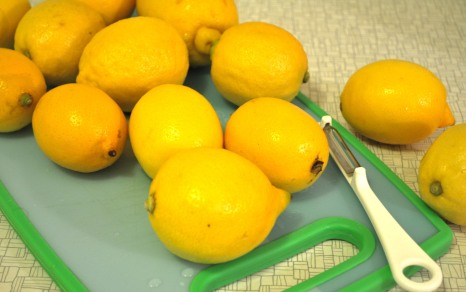
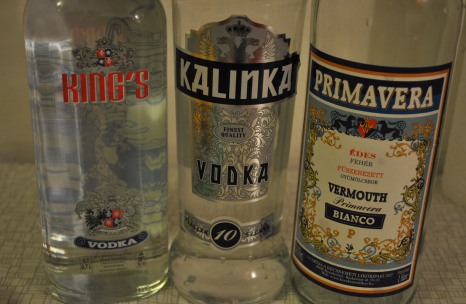
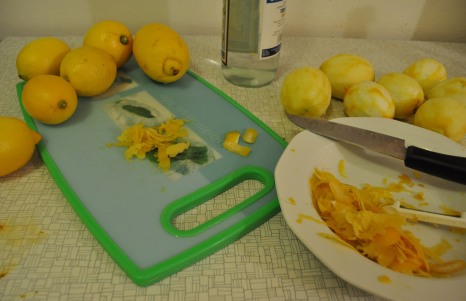
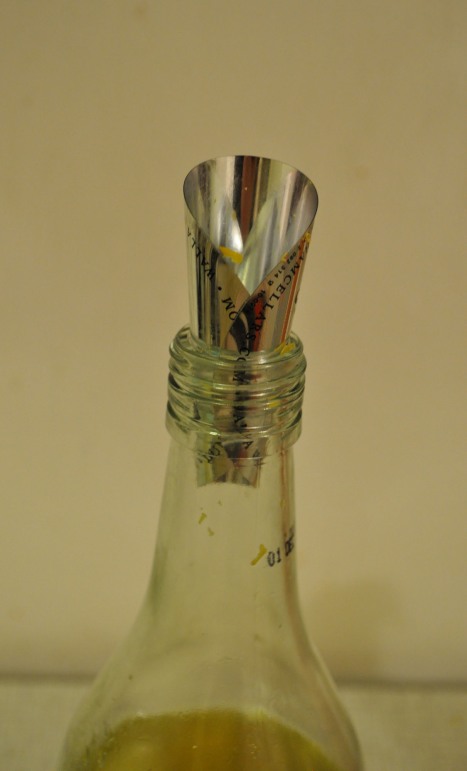
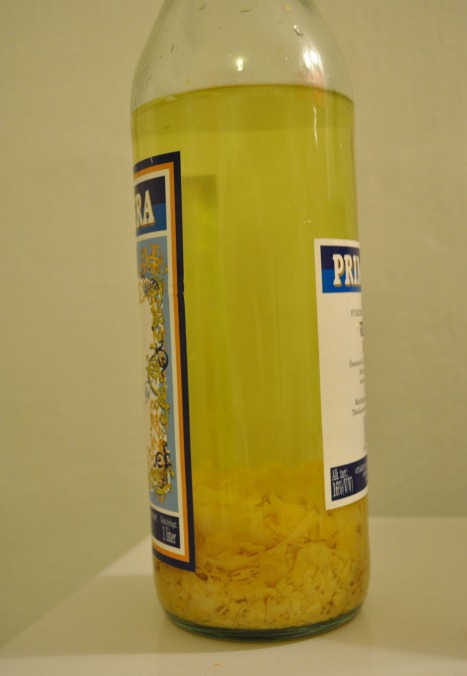
I wonder why bison grass is banned by the Fda? Ive never even heard of bison grass. Who knew limoncello was such a long process? I hope your time and patience and adaptations pay off!
It has something called coumarin in it, which supposedly is fatal to mice and is toxic to the human liver and kidneys. So it is banned as a food additive. This product is sold in the US, but they have to use an artificial color and flavor instead of the real stuff. I trust the European “FDA” more than I trust the US one, so I’m not concerned. I have read that people really like the taste of the real stuff so I might try it.
Bobby, I need to tell you that with one exception, I’ve always taken the peel off with a hand-held, generic vegetable peeler similar to the one you photographed. It’s harder to get only the colored part, but I don’t know why. I did once get tendonitis when I peeled two batches’ worth one season. 24 lemons = Ouch! I did think micro-planes would be easier to get there.
On the topic of the percent alcohol, if you can remember (or look up, or talk to a chem colleague at school) the chemistry math for concentrations, you should probably adapt the amount of simple syrup to your locally available proof of vodka. As I move toward creating predictable levels of alcohol and sugar (and not the random products I’ve put up with these last two years) in my limoncello, I’m increasingly doing this with all flavors. It’s really, really hard with fruit, though, because the sugar content varies from species to species and from season to season, and when that’s your baseline, one needs a way to measure the beginning sugar in order to determine the percent I want to add at the end. I’ve not got it all figured out yet, but I’m working on it.
Best wishes for a great success!
Suzan
Can do! I read that a pure grain alcohol should produce a 60 proof liqeuer while a 100 proof vodka should produce a 50 proof product. Does that make sense to you? The calculations are no problem, but, ultimately, what proof do I want the final product to be?